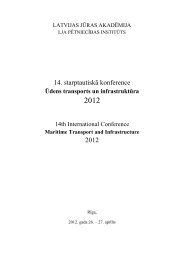You also want an ePaper? Increase the reach of your titles
YUMPU automatically turns print PDFs into web optimized ePapers that Google loves.
ConclusionsThe air conditioning simulation of 4 closed places of a bulk carrier. A mathematical model, includedthe energy given to the system, humidity and the balance of the mixture of fresh air from the externalplace with circulated air is established. Some of the heat gain and loss are neglected.It is accepted that the heat transfer from the ceiling, floor and side walls of the control volume isoccurred via conduction and convection. The system equations of heat loss are formed; capacitiveproperties of the walls are also taken into account. By using these equations, Models are created withMatlab-Simulink for each district. The created models are integrated with each other in Simulinkby taking the heat transfers of the districts with each other and with the external environment intoaccount for the simulation of all the ship’s air-conditioning system [15].PID controller obtained by the trial and error method is used in order to bring the indoor humidityand temperature values to the desired comfort conditions, ensures the continuity of conditions to increasethe energy efficiency [15].The temperature and humidity datum before the air-conditioning of all places in the ship areaccepted as 15 °C and 29,5 % humidity at the external conditions. The desired 25 °C and 45 % humidityare gained with the simulation. It is observed from the temperature-time and humidity-time graphs thatthe desired humidity and temperature parameters are reached without exceeding and steady state error.For future work, human factors and mechanical factors which affect the system disturbance can betaken into account for a new and improved model and solution.References1. Cherchas, D. B. A direct digital control algorithm for control of a single environmental space,ASME Trans., Vol. 107, December 1985, pp. 324-331.2. Zhang, Y., Baber, E. M. and Wood, H. C. Analysis of Stability of Livestock Building HeatingVentilation Control System, ASHRAE Trans., Research, 1993, 3715, pp. 237-244.3. House, J. M., Smith, T. F., Arora, J. S. Optimal Control of a Thermal System, ASHARE, 1991,IN-91-16-1, pp. 991-1001.4. Dexter, A. L., Haves, P. A Robust Self-Tuning Predictive Controller for HVAC Applications,ASHRAE, 1989, VA-89-1-3, pp. 431-438.5. Kamimura, K. et. al. CAT (Computer-Aided Tuning) Software for PID Controllers, ASHRAETrans., 1994, Research, 3754, pp. 180-190.6. William, T. P. Integrating Building Automation and Control, ASHRAE Journal, 54-58,September 1992.7. Atkinson, G. V., Martino, G. R. Control of Semiconductor Manufacturing Cleanrooms,ASHRAE, 1989, CH-89-1-1, pp. 477-482.8. Krakow, K. L., Lin, S. ve Zeng, Z. S. Temperature and Humidity Control During Cooling andDehumidifying by Compressor and Evaporator Fan Speed Variation, ASHRAE Trans: Research, 1995,3859, pp. 292-303.9. Krakow, K. L., Lin, S. ve Zeng, Z. S. Analytical Determination of PID Coefficents forTemperature and Humidity Control During Cooling and Dehumidifying by Compressor and EvaporatorFan Speed Variation, ASHRAE Trans: Research, 1995, 3863, pp. 343-354.10. Kaya, A. Analytical Methods for Controller Design, ASHRAE Journal, April 1976.11. Başer, A., Comparission of Energy Transportation Ways at Air Conditioning Systems, MSc.Thesis, Mechanical Engineering, Sakarya University, 2006.12. Öznergiz, E., The Optimal Control of a HVAC System by Microcomputer, MSc. Thesis,Mechanical Engineering, Istanbul Technical University, 1998.13. Araki, M., Control Systems, Robotics, and Automation, Volume II.14. Çelikel, H. K., Fuzzy Logic Tuned PID Control of Vehicle Suspension Systems, MSc. Thesis,Mechanical Engineering, Istanbul University, 2006.15. Koçal, T., Multi Zones HVAC Systems’ Control in Ships, MSc. Thesis, MechatronicEngineering, Istanbul Technical University, 2012.20
















